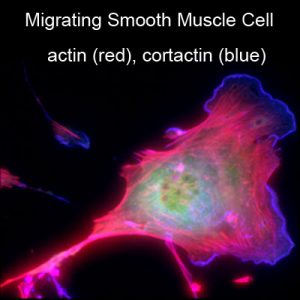Vascular
Regulation of Coronary and Outflow Tract Development (Arteriogenesis)
Smooth muscle cells play an essential role in maintaining the integrity of the vascular system and defects in their differentiation, migration, and proliferation are associated with several common (and severe) vascular diseases including some with congenital origins (ie DiGeorge syndrome and Tetralogy of Fallot) as well as those with adult onset (atherosclerosis, hypertension, restenosis). Appropriate regulation of smooth muscle phenotyes requires the assimilation of a variety of extracellular cues induced by growth factors, contractile agonists, cytokines, and extracellular matrix proteins (ECM) into activation of specific intracellular pathways. In our laboratory, we seek to explore how adhesive signals regulate these critical smooth muscle cells functions during vascular morphogenesis. We and others have shown that the tyrosine kinase, FAK, is strongly activated by both integrin- and growth factor receptor-engagement, and is poised to integrate multiple signals to regulate smooth muscle cells growth and motility. Indeed, with respect to vascular development, we have shown that conditional inactivation of FAK (by homologous recombination) in smooth muscle cells precursors led to persistent truncus arteriosus that was incompatible with post-natal life. Interestingly, we have also demonstrated that smooth muscle cells selectively express an endogenous FAK inhibitor (termed FRNK), and that FRNK expression “buffers” FAK signaling in these cells and promotes smooth muscle cells maturation. Thus, defining the FAK/FRNK-dependent signaling mechanisms that regulate these smooth muscle cells phenotypes will be important for our understanding of vascular development and will be critical for designing interventions that target aberrant smooth muscle cells responses in diseased vessels. We have identified several FAK binding partners that appear to be important regulators of smooth muscle cells chemotaxis and plasticity and we are currently exploring their role in promoting coronary vascular arteriogenesis and outflow tract remodeling.
